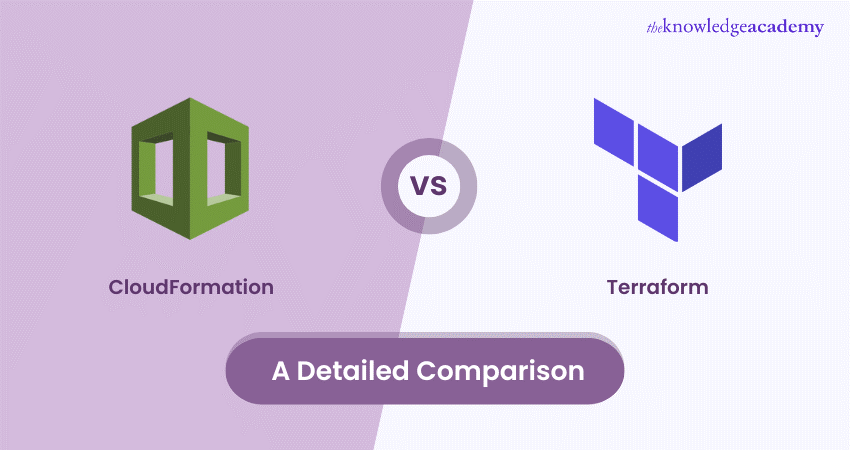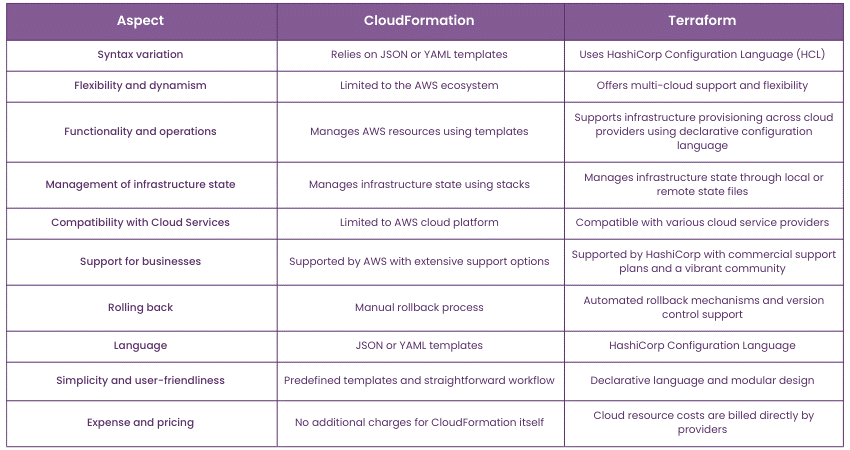We may not have the course you’re looking for. If you enquire or give us a call on +48 221041849 and speak to our training experts, we may still be able to help with your training requirements.
Training Outcomes Within Your Budget!
We ensure quality, budget-alignment, and timely delivery by our expert instructors.

In this blog, we will delve deep into the realms of CloudFormation vs Terraform, dissecting their features, functionalities, strengths, and limitations. By the end of this journey, you'll gain a thorough understanding of these powerful tools. This understanding will enable you to make informed decisions about which one best suits your organisation's needs and objectives.
Read this blog to unlock the potential of CloudFormation vs Terraform. Empower yourself to optimise your organisation's cloud infrastructure and drive efficiency in resource management. Let’s delve in!
Table of Contents
1) What is CloudFormation?
2) What is Terraform?
3) Difference between CloudFormation and Terraform
a) Syntax variation
b) Flexibility and dynamism
c) Functionality and available operations
d) Management of infrastructure state
e) Compatibility with cloud services
f) Support for businesses
g) Rolling back
h) Language
i) Simplicity and user-friendliness
j) Expense and pricing
4) Conclusion
What is CloudFormation?
CloudFormation, a service by Amazon Web Services (AWS), streamlines the provisioning of AWS infrastructure resources. It operates based on JSON or YAML templates, enabling users to define the desired configuration of resources in a declarative manner. With CloudFormation, users define required components like EC2 instances, databases, and networking resources, including configurations and interdependencies.
The specifications are included in a template that makes it easier for the resources to be supplied regularly. Consistency, repeatability, and version control are promoted by the single and flexible infrastructure management approach offered by CloudFormation templates. Entire resource stacks are able to be easily created, updated, and deleted by users, removing the need for laborious processes and reducing the possibility of mistakes in configuration.
Moreover, CloudFormation seamlessly integrates with various AWS services and features, including IAM roles, CloudWatch alarms, and Lambda functions. This enables comprehensive management of cloud infrastructure resources within a unified platform.
What is Terraform?
Terraform is an open-source Infrastructure as Code tool developed by HashiCorp that enables users build infrastructure across numerous cloud providers. A declarative configuration language forms its basis, allowing simple and brief code to define the ideal configuration of the infrastructure.
Terraform emphasises outcomes over methods, simplifying provisioning workflows for clarity and ease of use. By abstracting away the intricacies of Cloud Infrastructure Management, Terraform enables seamless orchestration of resources, regardless of the underlying provider.
Its versatility extends beyond individual cloud environments, offering a unified approach to managing multi-cloud deployments. Terraform enables efficient, scalable infrastructure management, automates tasks, and fosters agility in the dynamic cloud environment.
Join Terraform Training for seamless Cloud Infrastructure Management!
Difference between CloudFormation and Terraform
Understanding the differences between CloudFormation and Terraform is crucial for making informed decisions about managing cloud infrastructure.

1) Syntax variation
CloudFormation relies on JSON or YAML templates to define infrastructure. These templates can become verbose and complex, especially for large deployments. Users need to be proficient in JSON or YAML syntax to effectively manage CloudFormation templates. JSON and YAML, though common, may lack the intuitiveness and conciseness required for intricate infrastructure configurations.
Terraform uses its declarative language, HashiCorp Configuration Language. HCL offers a more concise and readable syntax than JSON or YAML. It provides a simpler and more intuitive way to describe infrastructure components and their relationships. This makes Terraform configurations easier to understand and maintain, enhancing overall productivity and reducing the learning curve for new users.
2) Flexibility and dynamism
CloudFormation's rigidity lies in its tight integration with AWS services, limiting flexibility to AWS-only environments. While it excels in managing AWS resources, its monolithic approach lacks the agility and versatility of Terraform's multi-cloud capabilities. CloudFormation users may find themselves constrained by AWS-centric workflows, hindering their ability to adopt alternative cloud providers or hybrid cloud architectures.
In contrast, Terraform's modular design and diverse provider ecosystem provide exceptional flexibility. Reusable modules simplify management across projects, while multi-cloud support allows seamless deployment across various providers, freeing organisations from vendor lock-in. This agility enables teams to quickly adapt to changing needs and effortlessly scale infrastructure.
3) Functionality and available operations
CloudFormation is an AWS service that enables users to provision and manage AWS infrastructure resources using JSON or YAML templates. It simplifies defining and deploying cloud resources, enabling automation and consistency in managing infrastructure within the AWS ecosystem.
Terraform, developed by HashiCorp, is an open-source infrastructure as a code tool that allows users to define and provision infrastructure resources across multiple cloud providers using a declarative configuration language called HashiCorp Configuration Language. It offers a unified approach to managing infrastructure and supports a wide range of cloud services.
Elevate your skills with AWS CloudFormation Training- join now to unlock advanced Cloud Management techniques!
4) Management of infrastructure state
CloudFormation manages the infrastructure state using stacks, which represent a collection of AWS resources that are provisioned and managed together. The state of the stack is maintained by CloudFormation and includes information about the resources provisioned, their configurations, and their dependencies. CloudFormation uses this state to track changes and manage the lifecycle of the stack and its resources.
Terraform manages infrastructure state by keeping track of the current state of the resources defined in its configuration files. This state is stored locally or remotely and serves as a record of the deployed infrastructure's status. Terraform uses state to plan and execute changes, ensuring actual infrastructure aligns with desired configuration files.
5) Compatibility with cloud services
CloudFormation is tightly integrated with Amazon Web Services and primarily supports provisioning and managing resources within the AWS ecosystem. While CloudFormation offers comprehensive support for AWS services and features, its compatibility is limited to the AWS cloud platform. This limitation makes it less versatile for multi-cloud deployments than Terraform.
Terraform offers broad compatibility with various cloud service providers, including AWS, Azure, Google Cloud Platform, and others. Its modular design allows users to define and manage resources across multiple cloud platforms. This flexibility avoids vendor lock-in and is enabled by an extensive provider ecosystem and unified configuration language.
6) Support for businesses
CloudFormation is supported by Amazon Web Services and benefits from AWS's comprehensive support infrastructure. AWS offers support plans for businesses, including enterprise-level options with 24/7 access to experts, personalised assistance, and architectural guidance. AWS also offers extensive documentation, forums, and user communities to support CloudFormation users.
Terraform offers robust support for businesses through various channels. HashiCorp, behind Terraform, offers commercial support, including enterprise-level plans with SLAs, dedicated engineers, and access to training. Additionally, Terraform has a vibrant community and extensive documentation, offering additional resources and assistance to users.
Begin your AWS Cloud Practitioner Training now to master cloud essentials!
7) Rolling back
CloudFormation does not have built-in rollback capabilities like Terraform. Users can manually roll back changes by updating the stack with a known configuration or by deleting and recreating it. CloudFormation supports change sets, enabling users to preview changes and minimising the risk of errors and the need for rollback.
Terraform provides mechanisms for rolling back infrastructure changes in case of errors or unexpected outcomes. It maintains a state file that records the desired state of the infrastructure, allowing users to revert to previous configurations easily. Additionally, Terraform supports version control systems, enabling users to track changes and roll back to specific versions if necessary.
8) Language
CloudFormation templates are written in JavaScript Object Notation (JSON) or Yet Another Markup Language (YAML) formats. JSON is a widely used data interchange format, while YAML is known for its readability and simplicity. CloudFormation templates define AWS resources, their properties, and their relationships using these formats, providing a structured and standardised approach to infrastructure provisioning.
Terraform uses its declarative configuration language called HashiCorp Configuration Language. HCL is designed to be human-readable and easy to understand, resembling traditional configuration formats. It allows users to define infrastructure resources, dependencies, and configurations in a concise and intuitive manner, enhancing readability and maintainability.
9) Simplicity and user-friendliness
CloudFormation aims for simplicity and user-friendliness by providing predefined templates and a straightforward workflow for provisioning AWS resources. While templates may become verbose for complex setups, CloudFormation's integration with AWS services offers an intuitive user experience.
Additionally, its graphical interface in the AWS Management Console enhances usability. However, managing large-scale deployments may require additional effort and expertise due to the limitations of JSON or YAML syntax.
Terraform offers simplicity and user-friendliness through its declarative configuration language and modular design. With its human-readable syntax and straightforward approach, Terraform makes it easy for users to define and manage infrastructure resources. Its modular design allows for better organisation and reuse of configurations, simplifying complex deployments and enhancing overall user experience.
10) Expense and pricing
CloudFormation does not incur additional costs beyond the usage fees for AWS resources provisioned through CloudFormation templates. Users are billed for the AWS resources they deploy, and there are no separate charges for using CloudFormation itself. However, it's essential to consider potential costs associated with AWS services used in CloudFormation stacks when estimating expenses.
Similarly, Terraform itself is open-source and free to use. However, there may be costs associated with using cloud resources provisioned by Terraform, such as compute instances, storage, and network resources. Users are billed directly by the cloud service providers based on their resource usage and pricing models.
Enhance your Cloud Computing skills with our Linux OpenStack Administration Training- join now!
Conclusion
In conclusion, both CloudFormation and Terraform offer powerful capabilities for managing and provisioning cloud infrastructure. CloudFormation vs Terraform choice depends on specific use cases, existing infrastructure, team preferences, and scalability requirements.
Begin your Cloud Computing journey. Explore our Cloud Computing Training today!
Frequently Asked Questions

The choice between Terraform and CloudFormation depends on factors like multi-cloud support (Terraform) versus tight AWS integration (CloudFormation). It also considers flexibility needs and team familiarity with respective syntaxes.

Terraform is faster because it can do many things at once, unlike CloudFormation. It's also more flexible, working with different cloud platforms simultaneously.

The Knowledge Academy takes global learning to new heights, offering over 30,000 online courses across 490+ locations in 220 countries. This expansive reach ensures accessibility and convenience for learners worldwide.
Alongside our diverse Online Course Catalogue, encompassing 17 major categories, we go the extra mile by providing a plethora of free educational Online Resources like News updates, Blogs, videos, webinars, and interview questions. Tailoring learning experiences further, professionals can maximise value with customisable Course Bundles of TKA.

The Knowledge Academy’s Knowledge Pass, a prepaid voucher, adds another layer of flexibility, allowing course bookings over a 12-month period. Join us on a journey where education knows no bounds.

The Knowledge Academy offers various Cloud Computing Training, including Terraform Training, Microservices Architecture Training and Linux OpenStack Administration Training. These courses cater to different skill levels, providing comprehensive insights into AWS Roadmap.
Our Cloud Computing Blogs cover a range of topics related to CloudFormation and Terraform, offering valuable resources, best practices, and industry insights. Whether you are a beginner or looking to advance your Cloud Computing skills, The Knowledge Academy's diverse courses and informative blogs have you covered.
Upcoming Cloud Computing Resources Batches & Dates
Date
 AWS CloudFormation Training
AWS CloudFormation Training
Fri 19th Jul 2024
Fri 18th Oct 2024









 Top Rated Course
Top Rated Course



 If you wish to make any changes to your course, please
If you wish to make any changes to your course, please


